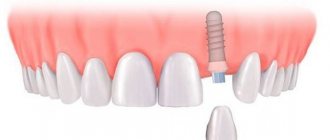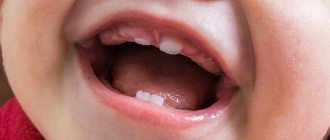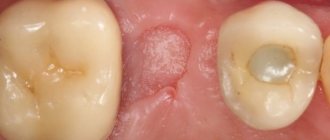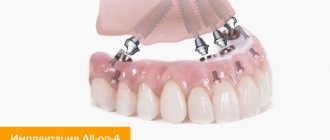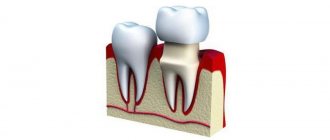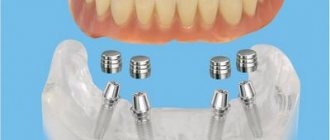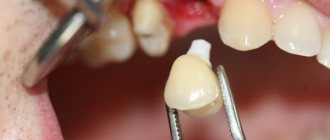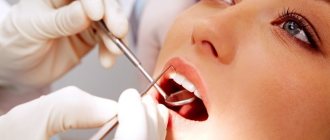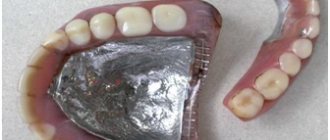7011
You can face such a delicate problem as the absence of many teeth at absolutely any age. And the main thing here is not to delay their restoration for long, but to perform prosthetics immediately after loss.
Modern dentistry for such patients is ready to offer several options for prosthetic structures, differing in the material of manufacture, method of fixation in the oral cavity and cost.
Problems associated with missing teeth in the upper jaw
The absence of teeth on any of the jaws means, first of all, the inability to eat normally and chew any food, which in turn leads to gastrointestinal diseases, weight loss, and a sharp deterioration in the quality of life. However, in addition to participating in the chewing process, the upper teeth perform an aesthetic function; they are directly responsible not only for the beauty of the smile, but also for the entire face. In their absence, wrinkles appear, the shape of the face becomes “heavier”, the skin and muscles without support in the form of teeth lose their elasticity and become flabby, i.e. Outwardly, a person looks older than his age, loses his youth and attractiveness. A patient with a similar problem loses the desire to communicate with others, he cannot realize himself in society, and cannot speak in public. Diction is also impaired, for example, he begins to lisp.
Missing teeth in the upper jaw serve many functions
Acrylic or nylon?
Which dentures are considered the best today: acrylic or nylon? It is quite difficult to answer this question unambiguously. To understand this and understand which dentures are best to install, you should consider all the advantages and disadvantages of the products.
- Flexibility and, of course, lightness. These indicators affect the strength of structures. For example, dentures made of nylon, due to the material, are very flexible, soft and lightweight. However, such structures are very difficult to break. In terms of flexibility and strength, acrylic dentures are inferior to nylon ones. But such structures can retain their shape for a long time. In addition, acrylic dentures are lightweight.
- Hygiene. This indicator is of particular importance to many. Nylon orthopedic structures do not emit odor, are non-toxic, and do not absorb moisture. Acrylic dentures have an exceptionally porous structure. It is because of this that a large number of bacteria accumulate on their surface, which can cause the development of inflammatory processes in the oral cavity.
- Appearance. What dentures are best to install so that they don’t stand out too much? In terms of color and shape, nylon structures are best suited. In addition, they are able to maintain an aesthetic appearance for a long time. The disadvantage of these prostheses is that the teeth are visible at the joints. As for acrylic removable structures, they can be selected not only by shape, but also by color.
- Hypoallergenic. In this regard, nylon structures have good biocompatibility, which cannot be said about acrylic prostheses. They can cause local and general allergic reactions.
- Price. Nylon removable dentures are more expensive than acrylic ones. The problem is that they are manufactured abroad. If we compare the cost of implantation and installation of removable dentures, then the cost of the latter method of prosthetics can be called affordable.
Features of the upper jaw that you need to know about
The upper jaw, compared to the lower jaw, is more fragile, it is less massive, the bone on it is softer and initially has a smaller volume, which is easily explained by the peculiarities of its functioning and purpose. So, if a person loses teeth on top, then the jawbone, without proper load, quickly succumbs to negative changes and decreases in volume. Therefore, the more time passes between the loss of a tooth and its restoration, the more difficult it is for doctors to carry out treatment, which sometimes cannot be done without complex and costly procedures, for example, osteoplastic operations and gum surgery.
The upper jaw, unlike the lower jaw, has a number of other features:
- proximity of the maxillary sinuses: if the patient decides to undergo prosthetics on implants, then this fact must be taken into account. If there is a lack of bone tissue, in some cases it will not be possible to do without bone grafting or it is necessary to select certain treatment protocols (one-stage implantation) and types of implants (for example, those installed in the jawbone at an angle), otherwise there is a risk of injuring the maxillary sinuses and causing not only rejection of implants, but also the appearance of chronic sinusitis,
- palate: taste buds are located on the palate, which are responsible for recognizing the taste of food and making the process of eating your favorite dishes enjoyable. However, if you choose the wrong prosthesis that covers the palate, then especially sensitive patients will experience severe discomfort, stop enjoying the process of eating, and they may also experience a gag reflex and increased salivation, because. dentures will constantly irritate the palate.
The upper jaw, unlike the lower jaw, has a number of features.
These factors must be taken into account when you choose one or another type of dental restoration.
Now let’s take a closer look at each of them separately with all the advantages and disadvantages.
Features of prosthetics in the absence of teeth
In the process of determining the method of prosthetics, a wide range of issues are taken into account, because with edentia there is not a single supporting element:
- Preference should be given to products that evenly distribute the load on the jaw under mechanical influence
The load that is generated during chewing food is completely directed to the prosthetic structure. This requires more careful consideration of the choice of materials for the manufacture of prostheses. You also need to take into account their functionality; preference should be given to products that evenly distribute the load on the jaw under mechanical influence.
- With uneven tooth loss, the bone tissue of the jaw atrophies in the places where units were previously located. This makes the process of implantation impossible. Thanks to innovative technologies in dentistry, it has become possible to grow tissue in problem areas of the jaw. Therefore, in some cases, before prosthetics, it is proposed to perform a sinus lift procedure.
- The peculiarity of installing a prosthesis is also a difficult adaptation period , when the patient cannot get used to the removable structure due to increased sensitivity or other reasons. The choice in such a situation becomes more complicated, because more comfortable designs differ significantly in price from inserted plate jaws.
- It is possible to achieve reliable fixation of a prosthesis in edentulous patients only with the help of techniques that involve preliminary implantation of implants to create support points for the structure.
Method No. 1: installation of classic removable dentures
If all teeth are missing, then the problem can be solved in the least expensive and simplest way, namely by installing classic full dentures. They can be made of nylon or acrylic, but doctors consider new generation prostheses with the addition of diamond chips or soft hypoallergenic Acry-Free more convenient.
The photo shows the Acry-Free prosthesis
All of them are fixed in the mouth by suction to the mucous membrane - you just need to press them well against the prosthetic bed and hold for a few seconds, all the air from under the structures will come out, and they will stick to the soft tissues of the oral cavity. It would seem that there is nothing complicated, but in fact the quality of their fixation will be good only if they fit tightly to the mucosa. But, as we noted above, mucous and bone tissue tend to atrophy if there is no adequate and correct load on them, which ideally can only be provided by the root of a natural tooth or its analogue - an implant. Those. under a removable denture, the bone atrophies and decreases in volume, and without frequent correction of the device to the characteristics of the mucous membrane, the patient has a hard time: the denture moves and falls out of the mouth, bends under the chewing load, rubs and causes pain.
Another disadvantage of classical covering systems is the presence of a palatal overlap, which is designed to improve the quality of fixation of dentures in the mouth. However, the artificial material blocks the palate, and the patient ceases to feel the taste of his favorite dishes.
This is, of course, the most budget option of all possible. The patient receives removable dentures literally 2-3 weeks after visiting the clinic - the time is spent mainly on the manufacture of devices in a dental laboratory. And there is no need to endure any surgical intervention. However, this option is not ideal, because... literally in the first days of use, most patients come to the conclusion that such prostheses are more likely to be a source of even greater problems than the best option for solving them. People experience discomfort, impaired articulation, and self-doubt due to unstable fixation of devices in the mouth.
Such designs often cause discomfort and discomfort.
As for food consumption, the load in dentures is distributed unevenly, so it is necessary to introduce restrictions on a number of food products. For example, you should not allow yourself to chew hard vegetables, meat, or whole fruits. If you do not follow the restrictions, the structures begin to sag, cause pain, and can become deformed and break. At the same time, they exert the main pressure on the gums, without affecting the bone tissue, which begins to atrophy. The more you wear removable devices, the stronger the atrophy becomes, as a result of which gaps form between the gum and the prosthesis, which requires immediate correction and relining of the product.
Materials for the production of prostheses
Prostheses that are installed on an implant and bridge structures can be made from various materials that have their own unique performance characteristics.
Metal-ceramic structures
A metal-ceramic prosthesis is a metal base, onto which a special ceramic mass is subsequently applied in layers. After each layer is applied, the structure is exposed to high temperatures in the oven. This production method allows us to obtain a finished prosthesis that is highly resistant to various negative external factors and mechanical loads. In this case, the prosthesis will look aesthetically pleasing and visually indistinguishable from the patient’s natural teeth. If the patient, after prosthetics, strictly follows all the dentist’s recommendations, observes the rules of hygiene and care of the prosthesis, the installed structure will be able to last 10-15 years.
Ceramic dentures
They are the best option for people with an allergic reaction to metals and their alloys.
The design does not use a metal base, but the prosthesis has excellent strength and high aesthetics. Thanks to this latter quality, ceramic crowns are actively used for prosthetics of teeth included in the smile area, but they can also be used for the restoration of lost chewing units. Another advantage of installing ceramic dentures is the ability to avoid preliminary pulp removal of supporting units. Metal structures made from alloys of various metals can also be used in prosthetics. The main advantages of this type of prosthesis are their high strength and affordable price, but at the same time they have the lowest aesthetics.
Experts recommend choosing metal dentures if you need to restore a lost chewing tooth that will not be noticeable to others.
Calculate the cost of treatment by taking a short test in 20 seconds!
Do not delay your treatment, because in this matter time plays against us.
Method No. 2: installation of dentures without palate
Palateless dentures have reduced or no palatal overlap. This is their main advantage over the classic ones. They cause less discomfort, are easy to get used to and care for, and allow you to feel the taste of your favorite food. However, the choice of such structures for those who completely lack all teeth on top is, in general, very limited, because For most types of support, either the patient’s natural teeth are needed (at least 2 units, or in some cases only roots are sufficient, for example, for dentures with locks), or implants. In such a situation, there are only two options.
The first is Quadroti prostheses (Quattro Ti). They are considered removable, can be not only partial, but also complete, have a small palatal overlap, made in the form of a thin plate with holes, which is almost not felt.
There is no palatal overlap in the designs
The second is dentures on implants. These are already non-removable systems, which are the only ones of all that really do not have a sky, because... there's simply no need for it. They are securely fixed in the mouth and return the patient to a full life.
Want to learn about all types of palateless dentures? Read our review on this topic.
One-piece removable denture with fastening from spherical abutments (locators)
This option is more improved. Its main difference from the first option is fixation. It is attached to the gums using special elements. This fixation allows you to stay in the same place. Fastening elements:
- locator. Fixed to a dental implant;
- plastic matrix. It is fixed in the prosthetic structure itself.
The matrix is snapped onto a ball-shaped abutment, which allows the prosthesis to remain in the same place for a long time. It is recommended to use at least two locators on 2 implants.
Advantages:
- reliable fastening. By attaching to locators, a reliable fixation is achieved , which allows you to stay in place and not move;
- price. Despite the fact that this design has also received good fixation to the jaws, the pricing policy remains the same. This prosthetic option is the most budget-friendly.
Flaws:
- fragility. In this option, the fastening already appears, but its quality does not change. The prosthesis is made of plastic. The lack of a high-quality frame means that the prosthesis is short-lived and is susceptible to various types of breakdowns;
- size. The size of a removable denture with fixation has sufficient scale dimensions for the oral cavity. Large pieces of plastic cover most of the gums and palate. You will need to get used to such a prosthesis. A violation of diction necessarily follows;
- load during chewing movement. When chewing, almost the entire load is directed to the 2 implants, which are the base. It is imperative to consult a specialist and follow the instructions. Due to the heavy load, there is a risk of being left without bone mass around the prosthetic area.
Method No. 3: classic two-stage implantation
The upper teeth are always visible to others, because when you smile, they are exposed to the greatest extent. If they are not there, this is serious damage to a person’s confidence in his attractiveness.
Implantation of teeth in the upper jaw according to the classic protocol, which experts also call two-stage, is an ideal option for restoring smile defects in terms of beauty and neatness. It is during its implementation that increased demands are placed on aesthetics. The beauty of a smile is achieved through the formation of an even gum contour and the use of individual abutments. But all the advantages of this protocol are offset by several negative factors.
The photo shows the process of classic two-stage implantation
Read the article on the topic: 6 stages of classical implantation.
Traumatic procedures
It’s rare that any of us loses all our teeth at once; in general, this process occurs gradually and is greatly extended over time. Accordingly, after the patient finally decides to restore them, the bone tissue of the upper jaw is severely atrophied. With a two-stage treatment protocol, it will be impossible to do without prior bone grafting. First, you will have to perform a complex operation and wait until the tissues heal and the artificial material takes root. The operation is considered quite traumatic, and the rehabilitation period for many is quite difficult, and the wait for the next stage, namely the installation of implants, takes a long time - 3-8 months.
Need to wait a long time
Classical implantation of the upper jaw in the absence of teeth is carried out in two stages and involves delayed loading with a prosthesis. The first is the installation of implants, the second is prosthetics. At least 3 months must pass between them for the implants to heal into the bone. Agree that the lack of teeth on top and the inability to get a new smile right away is a serious obstacle that directly affects self-esteem and communication with others.
High cost of treatment
Implantation in the absence of teeth on top using this protocol is very expensive. Each tooth is literally restored individually. The cost of treatment can reach 500 or more thousand rubles. It is difficult, expensive, and requires long-term rehabilitation.
Implantation for completely edentulous upper jaw is the only true and correct option for solving the problem. A prosthesis fixed on implants does not have a palate, it will never fall out of the mouth, and will also look as aesthetically pleasing as possible. However, implantation methods and options may vary. You need to give preference to those that will save your time and nerves.
If you don’t agree to wait a lot and pay a lot, then you can consider alternative options, namely implantation without bone grafting or, alternatively, one-stage implantation protocols with immediate loading of the prosthesis. According to the concept of comprehensive dental restoration, you do not have to spend a lot of time and effort to get a perfect smile. Within 72 hours (within 1-3 days) after installing the implants, the doctor will fix a permanent prosthesis, with which you can gradually begin to chew food.
Prosthetic options
Modern dentistry is ready to offer patients various and effective options for solving the problem of missing teeth in a row. You can choose not only a specific prosthetic technique, but also the material and type of prosthesis. A specific type of prosthetics is selected taking into account the following factors:
- Position of the tooth in the row;
- Duration of presence of the defect;
- Conditions of neighboring teeth and the oral cavity as a whole;
- Patient's financial capabilities.
The choice of prosthetic technique and the type of prosthesis that will be used to restore a lost dental unit is made by the doctor after examining the patient and performing a number of diagnostic measures. In case of single edentia, a specialist can offer the patient the following prosthetic options: implantation, prosthetics using a bridge or removable denture. Each technique has its own characteristics, which we will discuss in detail below.
Method No. 4: prosthetics on 4 implants from Nobel
If you haven't heard anything about this protocol yet, now is the time to find out. The protocol was developed by Nobel. The official name is all-on-4, because For its implementation, 4 original Nobel implants are used. The method has been working successfully for more than 20 years.
In this treatment protocol, the original implants specially developed by the company are recommended for use in cases of minor bone atrophy - due to this, bone grafting can be avoided. This treatment method helps restore teeth in both the upper and lower jaws.
The photo shows an implantation scheme on four implants
Read the article on the topic: 3 options for restoring all teeth on four implants.
“I had myself implanted with four titanium roots and was very pleased. What I liked most, of course, was the efficiency; within a week of vacation we got it done from start to finish. But I am saddened that I had to go to Moscow from Saratov to undergo treatment, because... In our city, doctors offered me only one option, where I had to wait a very long time.”
Manyunya, review from the dental portal gidpozubam.ru
How do you prepare for prosthetics?
Regardless of the chosen orthodontic structure, a preparatory stage is required before its installation. Its task is to bring the supporting teeth into good condition and avoid possible negative consequences (for example, the proliferation of pathogenic bacteria in the oral cavity).
Orthopantomogram is a mandatory stage of preparation for prosthetics
First of all, it is necessary to take an overview image of all teeth (orthopantomogram). This will allow the doctor to assess the condition of the oral cavity and detect a number of problems. Based on a thorough examination, an individual plan is drawn up. The preparatory stage may include the following activities:
- professional oral hygiene (removal of plaque and tartar);
- removal of carious lesions and nerves (if necessary);
- elimination of exostoses and osteophytes that complicate the installation of prostheses;
- turning (for reliable fixation of the crown);
- eliminating bleeding gums;
- performing a sinus lift (if implantation is planned);
- treatment of periodontal pockets.
Before prosthetics, the oral cavity must be sanitized
Method No. 5: All-on-6 or “all on six”
The minimum number of implants in the case of complete absence of teeth in the upper jaw is four. However, implants on the upper teeth, when there are only 4 of them, are not always able to adequately withstand the load from the prosthesis. The more bone loss you have, the more implants you will need to securely support your new fixed denture. For example, for these purposes, a specialist can install 6 artificial roots.
The entire prosthetic process often takes no more than a week
“All on six” or all-on-6, in fact, differs slightly from other innovative treatment protocols. The treatment is also carried out taking into account a thorough preparatory stage and the exclusion of contraindications, 3D modeling, based on computed tomography and the slightest structural features of the patient’s jaw, involves prosthetics as soon as possible (within 3 days after installation of the implants). The doctor who performs the work is required to be attentive and highly professional, and the patient is required to follow all the specialist’s recommendations and the need to start chewing immediately after installing the prosthesis - all this contributes to the rapid regeneration of bone cells, high primary stabilization of implants, eliminates the risk of complications, and shortens the rehabilitation period .
Types of designs
Types of prosthetics for complete absence of teeth:
- Comfortable removable denture. It rests on the soft gum tissue and is held in the mouth by vacuum. Disadvantages: poor fixation, mobility during chewing and speaking, difficult diction, bacterial growth (due to pieces of food getting under the structure), wounds may appear in the contact areas.
- Complete removable denture. The most budget option. This design is made from acrylic or acrylic-free plastic. The disadvantages are similar to the first type.
- Removable prosthetics in the absence of teeth with beam fixation supported by an implant. This is a convenient and comfortable option to wear. The beam structure consists of 2 parts: beams and matrices. To ensure that the chewing load is correctly distributed, the patient is given 4 implants (in the front part of the jaw). Advantages: reliable fixation without shifting, structural strength is achieved due to the metal base, most of the gums and palate are not covered.
- Fixed metal-ceramic option (on implants). This type does not have plastic parts and looks aesthetically pleasing. The soft tissue deficiency is covered with ceramics painted in the color of natural gums. Advantages: correct distribution of chewing load, comfort, strength, durability.
- All-zirconium prosthesis on implants. The most popular type. The design is light and does not cause discomfort. In appearance, zirconium dioxide is identical to natural teeth. It is also fixed with support from 4 implants. The benefits are similar to the type described above.
There is also prosthetics for complete absence of teeth using mini-implants. There are 3 types: products with 2, 4 and 6 implants.
Material used to make dentures
Prostheses are made from:
- Soft nylon. This is an elastic design with ideal aesthetics. Main disadvantages: low functionality and weak fixation.
- Acrylic. Affordable. They also have no contraindications for installation. They are held on the gums using a vacuum. Poor distribution of chewing load. Service life – no more than 5 years.
- Ceramics. This material is durable and similar in color to tooth enamel. It is possible to manufacture prostheses from glass ceramics based on lithium disilicate.
- Metal alloys. This material is mainly used for the production of crown frames, solid bridges, crowns without ceramic coating or clasp structures.
- Zirconia. The prosthesis is based on oxide or dioxide. These materials are white in color and are characterized by excellent strength.
Of the above materials, it is difficult to select the best one.
Important !
These materials can be used to make posterior teeth, anterior teeth, premolars and molars. The price of dentures for complete absence of teeth depends on:
- chosen design;
- material used;
- doctor's experience;
- selected clinic.
The stronger the prosthesis, the higher its cost.
Method number 6: basal complex
Implantation of the entire upper jaw is often associated not only with pronounced atrophic processes in the bone. Patients lose teeth for various reasons - inflammatory processes in periodontal tissues, smoking abuse, old age, and even diabetes. Often loss occurs due to illness. Patients with this set of problems often face refusal of help from doctors, but this will never happen to you if you contact a clinic and a doctor who deals with basal implantation.
Be sure to ask the doctors you are going to for treatment to present certificates, certifications, and training information - this is a completely normal requirement to guarantee your safety. After all, implantation in conditions of extreme bone atrophy or inflammatory process is a risk if you contact an unqualified specialist. It’s even better if the clinic provides extended guarantees for the work of its staff and offers service as bonuses, rather than trying to “get rid of” the patient immediately after receiving the money.
What is this concept? Complete refusal of bone grafting, work on restoring teeth on the entire upper (in relation to the lower) jaw with the help of a large number of implants - depending on the atrophy of the bone, there can be from 8 to 12 pieces. The implants are single-component, have a smooth neck and an antimicrobial coating, and involve deep layers of bone, which reduces the risk of developing peri-implantitis and postoperative complications. They are installed under anesthesia (it is also possible to use general anesthesia or sedation according to indications), literally screwed into the bone without unnecessary incisions and stitches. The fixed prosthesis is fixed in 1-3 days.
The photo shows basal implantation in the upper jaw
As for the price, dental implantation of the entire upper jaw using the basal protocol will pleasantly surprise you; it starts from 250 thousand rubles. Still, comprehensive restoration of defects allows the patient to significantly save money. And this is another reason to choose the method as one of the most worthy options. If you want to protect yourself in terms of cost, pay attention to clinics offering.
Until recently, one-stage implantation methods, in particular the basal complex, were perceived by patients as the last hope that would help restore a full life. People took this step without hiding their fear. This was due to a lack of information about these treatment protocols. Today, thanks to the availability of information and successful practice, the situation has changed radically - an increasing number of patients in Russia understand that these methods are just one of the effective options, and not a desperate step towards salvation. However, you need to remember that to this day in Russia there are very few specialists who have the skills to work with one-stage treatment methods and the necessary certification; accordingly, it is easier for doctors without experience to offer you complex, expensive classical implantation or install removable dentures, as well as spread myths about the danger basal implantation".
What is the danger of complete tooth loss?
There are practically no people in the world who are not affected by the problem of caries and tooth decay.
At first, a person tries to solve it, goes to the dentist for sessions, looks for the best solutions, but over time, one gets used to this situation, and most often the problem remains unresolved until complications arise.
Everyone knows that our body is perfect, and the loss of any of its organs will sooner or later lead to undesirable consequences.
Over time, the body’s work is restructured, the absence of one organ is compensated for by another.
The same thing happens in the oral cavity: the load of the removed tooth is distributed between the last teeth, and their work becomes more difficult.
Different groups of teeth perform their functions. So, the front ones help to bite off food, and the side ones crush the food and form it into a food bolus of the required consistency.
The absence of at least one tooth in the dentition significantly affects a person’s appearance. The skin at the site of the missing tooth becomes not as elastic as before, and wrinkles appear. The lower third of the face is distorted.
After a tooth has been removed, the bone atrophies and becomes thinner, which disrupts nutrition in the tissue.
This process is manifested by a decrease in the number of blood vessels in the place where the tooth was removed and a weakening of the bone structure. As a result of such processes, teeth can shift and the bite is disrupted.
Due to a lack of teeth, muscle tone is disrupted, wrinkles form, the cheeks can fall inward, and the oval of the face changes.
If the teeth were removed from the front, the lips fall inward, the nasolabial fold deepens, and the corners of the mouth droop. All this leads to facial asymmetry, muscle tone weakens, and signs of aging appear.
The main function of teeth is to grind food. If food is not chewed enough, it can cause digestive difficulties and various diseases of the gastrointestinal tract.
Insufficiently chewed and undigested food is poorly absorbed by the body, resulting in a lack of nutrients, vitamins, and microelements. All this affects the general condition of the body and its protective abilities.
In addition, the absence of teeth also affects a person’s speech. Due to the lack of teeth, articulation is impaired, sometimes a person cannot pronounce individual sounds.
Method No. 7: zygomatic implantation
This is a unique opportunity for patients with acute bone atrophy and adentia in the upper jaw, thanks to which it is possible to restore teeth in a matter of days and avoid surgery to build up bone tissue.
Zygomatic implants in dentistry were initially developed for patients who found themselves in difficult life situations, suffered serious injuries to the jaw, underwent oncological treatment, or had extreme bone atrophy in the upper jaw. They were called to serve almost for life.
The photo shows Nobel Zygoma Implants
Zygomatic dental implantation cannot be considered as an independent method - in fact, it is an improvement of already known methods discussed above, in particular all-on-4 and all-on-6. It is based on complex dental restoration with classical implants, to which, in the case of extreme bone atrophy, 2 to 4 zygomatic implants are added (or simply 6 zygomatic models are used). They have an extraordinary length, up to 6 centimeters. However, you should not be afraid of it, such models penetrate into the deepest layers of the bone (sterilely clean) - basal, cortical, and are attached to the cheekbone. The strength of their attachment and primary stability are very high, so you can immediately install a prosthesis on them and start chewing food.
Many patients wonder: is it dangerous to place implants on the upper jaw? Some people are especially intimidated by the installation of long cheekbone implants. The practice of using transzygomatic implants indicates that the main reason for their loss or complications after installation is a violation1 of the preoperative preparation protocol and non-compliance with the treatment planning protocol by the doctor.
From the above, we can conclude that their installation is not dangerous, but only on condition that thorough preparation for treatment based on 3D modeling has been carried out, and it is the maxillofacial surgeon, an implantologist with considerable experience, who is involved in restoring the integrity of your smile. In this case, the specialist must necessarily study the results of a computed tomography scan of the patient’s jaw for the presence of inflammatory processes in the maxillary sinuses - they must be excluded and the sinuses sanitized. In addition, you need to remember that such implants are installed obliquely - this eliminates injury to the maxillary sinuses and complications during surgery.
Do not forget that the success of zygomatic implantation of the upper jaw in the absence of teeth largely depends on the patient himself, on his responsibility and consciousness, on how carefully he will follow the doctor’s recommendations after the procedure.
It is worth saying a few words about what models of artificial roots are used for this method of treatment. First of all, these are Zygoma zygomatic implants from Nobel Biocare. Today, the concept of “zygomatic implantation using the Zygoma system” can already be considered a household word, because It was the models from this manufacturer that for the first time gave patients with acute atrophy of the jaw bone a real chance to qualitatively solve the problem of edentia and get teeth quickly. Such models are technically advanced, have passed more than one clinical trial, have proven themselves with many years of successful experience in use, and therefore have earned respect among doctors and patients all over the world. Models from manufacturers Noris Medical, Biomed, and Belarusian Radix also occupy their market share.
The price for restoring the upper jaw with zygomatic implants will be high – from 480 thousand rubles. But you will quickly receive a permanent, functional prosthesis and a beautiful smile.
Notice
: Undefined variable: post_id in
/home/c/ch75405/public_html/wp-content/themes/UltraSmile/single-item.php
on line
45 Notice
: Undefined variable: full in
/home/c/ch75405/public_html/wp-content /themes/UltraSmile/single-item.php
on line
46
Rate this article:
( 3 ratings, average: 5.00 out of 5)
implantation
- Put V.A., Solodkiy V.G., Svyatoslavov D.S. Practice of using transzygomatic, angular and multicortical implantation protocols in patients with extreme maxillary atrophy. Chief Doctor of the South of Russia, 2020.
Consulting specialist
Dzhutova Aida Vladimirovna
Doctor rating: 8.8 out of 10 (5) Specialization: Implant surgeon, periodontist Experience: 8 years
Reliable fixation using mini-implantation
For cases where full-fledged classical implantation cannot be carried out, and the patient is completely unprepared to use removable dentures, it is possible to use a conditionally fixed technique. It involves, on the one hand, reliable fixation of the prosthesis, and at the same time the patient has the opportunity to remove and put it on independently. Of course, such fixation does not allow you to restore chewing function in the same way as with conventional implantation, but it allows you to calmly chew food and communicate without fear of the prosthesis falling out of your mouth.
Mini-implants are very thin implants; they are a one-piece structure; the prosthesis is immediately fixed on them, without the use of additional superstructures. The lower part of the mini-implant - its main body - is similar to a thin screw; it is installed into the jaw bone transgingivally - without cutting the gums, and the outer, smaller part, shaped like a ball, serves as a stopper for the prosthesis. Mini-implants are used to fix a removable denture on the jaw; in this case, the denture is also called an overdenture. A small bone volume is not an absolute contraindication; after installing mini-implants, a prosthesis can be installed immediately. Such implants are not used as a support for crowns, only for fixing a removable denture, acting as a retainer.
The spherical heads of mini-implants are snapped into special locks installed inside the prosthesis.
The mini-implant is made of titanium and is similar to a screw, but much smaller. There are significantly fewer contraindications for their installation than for classic root-shaped implants, only extreme cases of systemic diseases.
This type of implant is installed through surgery; it is possible to use implant templates. It is very important to maintain strict hygiene during this period of time and follow all doctor’s instructions.
